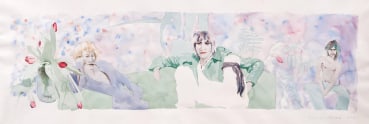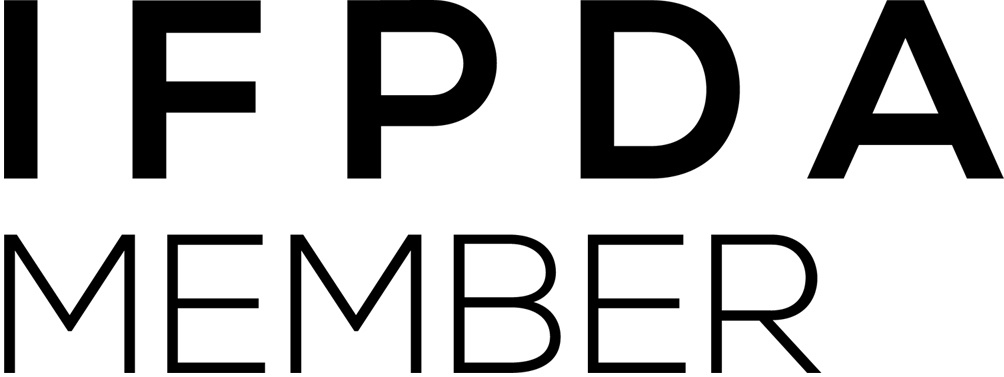Fear Gives Wings to Courage
Cork Street 100
Curated and titled by Tarini Malik, Curator of Modern and Contemporary Art at the Royal Academy of Arts, the exhibition Fear Gives Wings to Courage celebrates 100 years of Cork Street as a landmark art destination.
As part of the street wide collaboration, the Redfern Gallery are proud to exhibit a series of five prints by Patrick Procktor RA (1936–2003). These lyrical and dreamlike compositions of Procktor’s boyfriend, Gervase Griffiths, and friends – the designer, Ossie Clark, and the actor, Eric Emerson – relate to poetic reverie, and the spiritual ascent into the unknown.
Invitation to the Voyage was conceived in New York, when Procktor and three friends spent a whole day sitting on sofas inside an apartment, whiling away the hours with regular if rambling conversation about classical gods and current events. It was intensified by the room’s mirrored walls, which brought the outside Central Park, as well as the gradual changes of light – encompassing daylight, dusk and moonlight – ‘into’ the room.
As Procktor later explained, “there are many reasons that I could offer for the fascination the original occasion had for me, but they changed and renewed themselves when it came to making the aquatints”. This included a “Baudelairean inspiration”, and it is important to note that each print was accompanied by typed excerpts from Les Fleurs du mal. Procktor was chiefly interested in L’Invitation au voyage, after which the series is titled. This love poem describes how memory, imagination and association of ideas combine to create a transcendent, idyllic dream world. Throughout Les Fleurs du mal, quiescence is associated by Baudelaire with immobility and depression. But in L’Invitation au voyage, quiescence is conducive to poetic reverie, with Baudelaire conjuring an alternative paradise as a way of escaping the harsh realities of life. It is this spiritual ascent into the unknown, the ‘invitation to travel’, that informs Procktor’s imagery. His lounging figures hover like illusory, disconcerting fragments snatched from recollections of a dream. The delicate tonality of the ink, and the manipulation of plate-tone, enforces further this sense that the images are at once ethereal and ephemeral, with certain details apparently on the cusp of disappearing altogether. Some of the colours are sharp while others are soft, as if suggesting how Procktor’s memories alternate between vivid and vague, just as Baudelaire’s idyllic dream world is threatened by moments of ambiguity.
Baudelaire likens his imaginary world to ‘a multi-coloured gem’, and several prints are suitably kaleidoscopic in colour. But, perhaps somewhat paradoxically, white is the dominant force in each composition. Much of the plate is left untouched, with Procktor now embracing the white paper, which is cleverly incorporated into the overall image. The white paper not only represents the intensity of the light as it engulfs the room, but helps to create a palpable sense of weightlessness, with all notions of time and space suspended, as is necessary for the realisation of Baudelaire’s dream world. In trying to convey the expansive and unlimited movement of poetic reverie, Procktor ended up working on plates measuring some thirty inches wide. In titling one of his prints Language of Flowers, Procktor refers to a line in another, similar poem, Elevation, wherein Baudelaire can understand ‘without effort the language of flowers and other mute things’, such is the extent of his joyous transcendence.
However, the ecstasy of both poems is countered by the more fearful passages of Chant d’automne, which Procktor chose to accompany Departure and Ossie, Gervase and Eric, while Le Crépuscule du soir accompanies Sadie and Prudence. In the latter poem, Baudelaire considers the importance of dusk, focusing on its symbolic bridging of daylight into darkness. Similarly, Chant d’automne is a lamentation on how summer has been supplanted by autumnal gloom. Most of the dying hospital patients soon to succumb to permanent darkness, concludes Baudelaire in Le Crépuscule du soir, ‘have never known the solace of a home and have never lived!’ Such bittersweet sentiments resonated with Procktor, keenly aware that his brief but intense relationship with Gervase was now almost over. In this sense, Departure as a title has a double meaning, implying an elated departure from reality as well as a reluctant severance of romantic ties. Ultimately, Invitation to the Voyage was Procktor’s final statement on Gervase.
Works
-
 Patrick Procktor RAEgo, 1969Watercolour on paper63 x 101 cmSigned and dated lower right
Patrick Procktor RAEgo, 1969Watercolour on paper63 x 101 cmSigned and dated lower right -
 Patrick Procktor RALanguage of Flowers, 1969-70Aquatint45 x 75 cm (image)From the edition of 75 impressionsSigned and numbered
Patrick Procktor RALanguage of Flowers, 1969-70Aquatint45 x 75 cm (image)From the edition of 75 impressionsSigned and numbered -
 Patrick Procktor RASadie and Prudence, 1969-70Aquatint25 x 45 cm (image)From the edition of 75 impressionsSigned and numbered
Patrick Procktor RASadie and Prudence, 1969-70Aquatint25 x 45 cm (image)From the edition of 75 impressionsSigned and numbered







